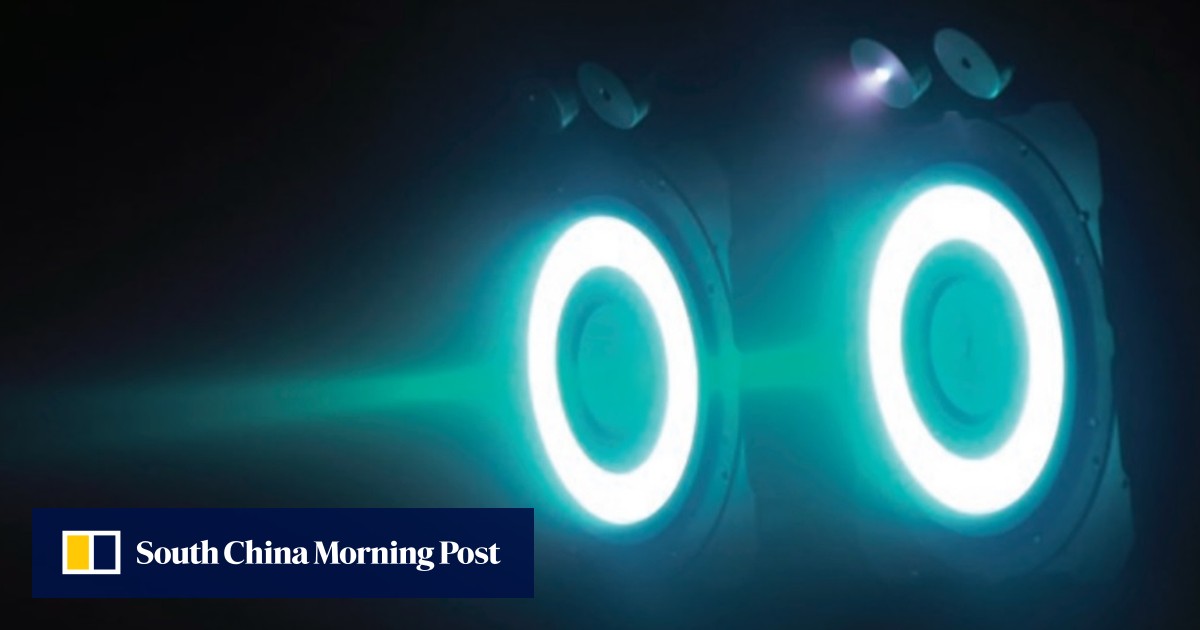How China’s space station could help power astronauts to Mars
- The Tiangong’s core module is set to become the first crewed vessel powered by ion drives – a technology that could slash journey times to the red planet
- The thrusters have been in use since the 1970s, but China hopes to develop them on a much larger scale for its deep space missions
China’s Tiangong space station could help pave the way for a manned mission from Mars with its use of a propulsion system that has never before been deployed for a manned spacecraft.
The space station’s core Tianhe module is powered by four ion drives – also known as Hall effect thrusters – a form of electronic propulsion that has been around for decades and could dramatically slash the time needed to travel to the red planet.
The four ion drives that power the Tianhe module, which is expected to welcome its first astronauts later this month, are small compared to rocket engines but they are incredibly efficient.
The International Space Station, for instance, consumes over four tonnes of fuel annually to stay in its near-Earth orbit. If powered by ion thrusters, its consumption would drop to 400kg (881lbs), requiring just one refuelling mission a year, according to the Chinese Academy of Sciences.
With existing rocket technology, a crewed trip to Mars would take more than eight months and would need a spaceship large enough to carry sufficient fuel and other supplies.
Meanwhile, China which has already used it on some of its satellites, plans to use it in a wide range of areas, ranging from extremely precise satellite constellations that can pick up gravitational waves (small ripples in space-time), new-generation commercial and military satellites – and a fast, nuclear-powered spaceship that can take astronauts to Mars.
Most ion thrusters that have been used in space generate around 1 kilowatt in power, but China is planning to make them much bigger as part of its ambitious space programme.
“For large space missions such as human deep space exploration, the power of the electric propulsion system may exceed 5MW even up to 500MW. Higher power means a shorter transit time to the exploration target,” wrote Hang Guanrong and colleagues with the Shanghai Space Station Institute, in a paper published in domestic journal Aerospace China.
Hall effect thrusters are named after Edwin Herbert Hall, an American physicist who discovered in the 1930s that electrically charged particles could produce a thrust, but Soviet scientists and engineers were the first to bring the theory to life.
The Soviets started making numerous types of Hall thrusters for their satellites in the 1970s and even sold some of these engines to Nasa.
While Nasa also started building its own, the American space authorities treated the ion engine as a sideshow for a number of reasons.
The thrust produced by the electric propulsion system was usually quite small. More importantly, charged particles could erode engine components and could shorten the lifespan of satellites and put astronauts in danger.
In China, scientists have been working away to improve the technology without attracting attention. The Shanghai Space Station Institute did not even have a registered postal address and none of its research has been publicised.
“Except for a few experts in the field, most people outside don’t know about their existence,” said a Beijing-based space scientist who asked not to be named due to the sensitivity of the programme.
Heng wrote that in Shanghai, ground testing had started on HET-3000, a 50KW engine “designed mainly for large-scale crewed missions, cargo transport missions to the moon and Mars”.
When fired up, the ion drive produces bluish fumes and halo rings that are caused by extremely hot, electrically charged particles leaving the engine at 30-plus times the speed of sound.

How China’s space station could help power astronauts to Mars
The Tiangong’s core module is set to become the first crewed vessel powered by ion drives – a technology that could slash journey times to the red planet.
 www.scmp.com
www.scmp.com
How China’s space station could help power astronauts to Mars
The Tiangong’s core module is set to become the first crewed vessel powered by ion drives – a technology that could slash journey times to the red planet.

